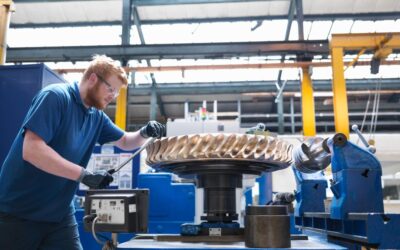The reality is stark: the average overall efficiency of equipment in the manufacturing industry is 55-60%, and only 6% of plants reach the World Class of 85%+. This often comes as a rude shock to production managers, who discover that their manual OEE calculation masks 10-30% of hidden productive capacity.
In 2025, with the OEE solutions market set to reach USD 12 billion by 2033, the priority is no longer “should we measure?” but “how can we guarantee the reliability of our data?”. In this article, we break down the 7 fatal errors that distort your metrics, with numerical examples from McKinsey, Evocon and Symestic studies.
Why OEE Calculation is Essential
OEE (Overall Equipment Effectiveness) combines three critical dimensions of production time:
OEE = Availability × Performance × Quality
McKinsey documents substantial gains linked to a precise calculation:
- 30-50% reduction in machine downtime
- 10-30% increase in production output
- 15-30% improvement in productivity
Case in point: a pharma plant moving from 37% to 60% OEE generates an annual return of 14-16 million USD (McKinsey, 250 days/year, 16h/day, 40% margin).
Benchmarks by sector
- Pharmaceuticals: 35-37% average, 70% World Class
- Agri-food: 70-80% average, 80-85% leaders
- Automotive: 75% average, 84-86% lean factories
- Electronics: 80-83% average, 85%+ leaders
The facts: Most factories operate 20-30 points below World Class, often without realizing it.
The 7 Fatal Errors in Manual Calculation
Error #1 – Invisible Micro-Stops: 15-20% Losses in Availability
The problem: These stoppages of a few seconds (jams, sensors, adjustments) escape manual collection. 50 micro-stops of 3 minutes = 2h30 lost.
Impact in figures: DBR77 Robotics establishes that microstops account for 15-20% of lost time. Symestic documents:
- 50 stops × 3 min = 150 minutes
- Over 8h (480 min) = 31.25% loss of availability
Nutriset case study: the agri-food customer eliminated these 3-4-second “irritants” occurring 50-100 times/station, resulting in +11% OEE in 8 years.
Solution: IoT sensors capture every event from the very first second, without human intervention.
Mistake #2 – Average Speeds: 5-25% Hidden Potential in the Company
The problem: Using historical average speed instead of manufacturer’s nominal speed artificially inflates scores.
Symestic example: Manufacturer specifies 3 sec/part, real time observed 4 sec. Production of 1,000 parts in 3,300 seconds:
Correct calculation (manufacturer’s speed):
- Theoretical = 3,300 ÷ 3 = 1,100 pieces
- Performance = 1,000 / 1,100 = 90.9% (visible gap: 9.1%)
Miscalculation (average speed):
- Theoretical = 3,300 ÷ 4 = 825 pieces
- Performance = 1,000 / 825 = 121.2% (impossible!)
Impact: Worximity warns that this error masks opportunities for improvement. Correcting it reveals 5-25% improvement potential.
Error #3 – Counted touch-ups: 8 Quality Deviation Points
The problem: Counting reworked parts as “good” in the quality rate distorts the index.
Symestic example: Production of 1,000 pieces :
- 900 immediately compliant
- 80 requiring touch-up
- 20 scraps
Incorrect calculation: (900 + 80) / 1,000 = 98% Correct calculation (First Pass Yield): 900 / 1,000 = 90% Difference: 8 points
Principle: Worximity specifies: “Only parts that are flawless from the first pass count. Including rework masks problems in the production process.”
Error #4 – Classification of Stops: Impact on Availability
The problem: Evocon identifies incorrect categorization of stops as error #1. Unplanned stops become “planned” to improve scores.
Stick culture: TipTeh explains, “When data is used as a disciplinary stick, teams incorrectly classify stops to mask problems.”
Classic confusion:
- Preventive maintenance: planned downtime or reduction of available time?
- Format changes: fully excluded, partially included, or fully counted?
- Breaks: included or excluded from the calculation?
Impact: Masks opportunities for improvement and gives a false impression of optimization.
Error #5 – Inaccurate manual data
The problem: Scytec warns: “Manual data entry leads to human error.” The classic “Have you filled in your sheet?” produces approximate data.
5 causes of inaccuracy:
- Memory data (end of shift)
- Input errors (450 vs 540 pieces)
- Inconsistent methods between teams
- Under-utilization of talent (paperwork vs. production)
- Obsolete data (analysis last week)
PSA Stellantis case study: Christophe Pasquet confirms the considerable time freed up for operators, who can concentrate on production.
Error #6 – Confusion of Time Units
The problem: Mixing minutes, seconds and hours produces absurd results.
Symestic example: 390 min runtime, 45 sec/part, 500 parts
Incorrect (mixed units): (45 × 500) / 390 = 57.7 (absurd) Correct (seconds): (45 × 500) / (390 × 60) = 96.2% .
Recommendation: “Check unusual results for unit errors” (Symestic).
Error #7 – Lack of Multi-Site Standardization
The problem: Evocon identifies lack of standardization as critical error #7. Without a single methodology, it’s impossible to compare sites.
4 sources of inconsistency:
- Variable definitions of available time
- Different treatment of changes
- Inconsistent reference speeds
- Variable quality categorization
Pitfall: Worximity warns of inappropriate comparisons (1 change/day vs. 4-5 changes/day).
Eolane case study: Vincent Perrault uses a standard multi-site tool for uniform monitoring, with significant cost savings.
Solution: The 4 Pillars of Automation
1. Automatic Collection
IoT sensors capture every event in real time. Eliminates errors #1 (micro-stops) and #5 (inaccurate data).
2. Standardized calculation
Automatically applies the right formula, right categories, right units. Eliminates errors #2, #3, #6, #7.
3. Intelligent categorization
Stops classified according to configurable rules, applied 24/7. Eliminates error #4.
4. Analysis of Causes and Alerts
Pareto-transformed data, trends, correlations. Automatic root cause analysis. Proactive drift detection.
Documented ROI
McKinsey earnings:
- 30-50% reduction in downtime
- 10-30% increase in throughput
- 20-40% machine life
- 4-10% EBITDA improvement
Documented cases:
- HKScan: +20% OEE in 6 months
- Toftan: +35% OEE in 1 year (40%→75%)
- Auto: -25% unplanned stops (McKinsey)
Typical ROI: 6-18 months depending on installation size.
FAQ – Frequently asked questions about OEE
How to calculate OEE correctly?
OEE = Availability × Performance × Quality
Availability = Actual time / Planned time Performance = Actual part quantity / Theoretical (manufacturer’s speed) Quality = Good parts (First Pass) / Total produced
Example: Shift 8h (480 min), breaks 30 min, stops 45 min
-
Availability = 405/450 = 90%.
-
Performance = 385/405 pieces = 95%.
-
Quality = 377/385 = 98
-
OEE = 83.8
Why is my manual OEE superior to the automated one?
Normal! Automated is typically 5-15 points lower because it captures :
-
Micro-interest (15-20% hidden losses)
-
Actual vs. average speeds (5-25% potential)
-
Touch-ups excluded (8-point spread)
-
Correct classification of stops
-
All input errors eliminated
What makes a good OEE?
General standards:
-
< 60%: Insufficient (world average 55-60%)
-
60-75%: Acceptable SME
-
75-85%: Good level
-
> 85% : World Class
By sector:
-
Pharma: 35-37% average, 70% World Class
-
Agri-food: 70-80% average, 80-85% leaders
-
Automotive: 75% average, 84-86% lean
Important: Only 6% reach 85%+ (Evocon). Aim for continuous improvement: +5 points/year.
Conclusion
Only 6% of manufacturers reach World Class, with the majority operating at 55-60% and thinking they are at 70-75%. This difference represents hundreds of thousands of euros of hidden capacity during the production period.
Key points
Automation costs less than manual work:
- Administrative time saved
- 10-30% hidden capacity detected
- Decisions based on real data
Documented rapid ROI:
- Payback < 6-18 months
- Gains 10-30% throughput, 30-50% downtime reduction
- Solutions available from €99/month
Next steps:
- Self-diagnosis: how many mistakes do you recognize?
- Estimate your displayed vs. actual OEE gap
- Pilot 1 month on critical line
Free tools for taking action
Calculate your ROI in 2 minutes How much are these 7 mistakes really costing you? Our calculator estimates your potential gains and personalized return on investment.
See the solution in action
20-minute demonstration tailored to your sector: visualize your data in real time.
In 2025, operational excellence starts with reliable data. Your satisfaction depends on the quality of your indicators.





0 Comments